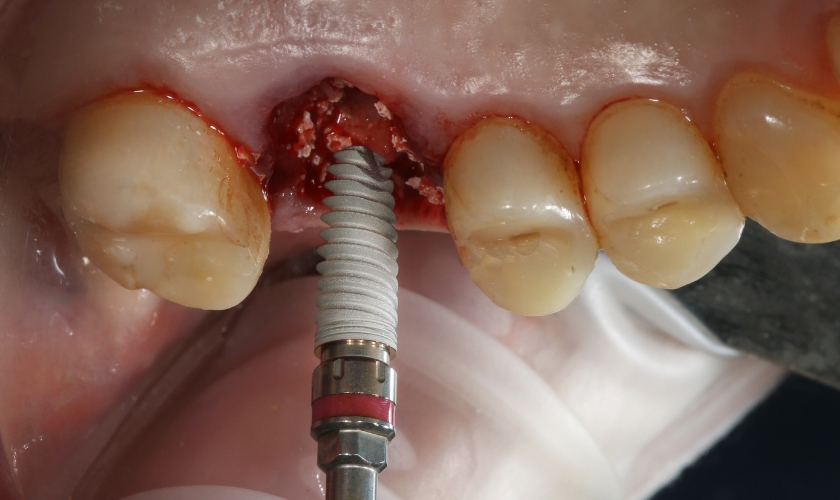We are not a registered Medicare/Medicaid Provider

Dental implants are revolutionary tooth replacement solutions mimicking the natural function and aesthetics of teeth. But have you ever wondered how these implants integrate seamlessly into your jawbone and create a stable foundation for your new smile? The answer lies in a fascinating biological process called osseointegration.
Bone Fuses with the Implant: A Microscopic Marvel
Osseointegration is the fusion of bone tissue with the surface of a dental implant. Here’s a breakdown of this microscopic marvel:
- Biocompatible Materials: Dental implants are typically made of titanium, a biocompatible material that the body readily accepts. This minimizes the risk of rejection and allows for close contact with bone tissue.
- The Healing Cascade: After implant placement, the surrounding bone responds by forming a blood clot around the implant surface. This clot attracts specialized cells called osteoblasts, which are responsible for building new bone.
- Osteoblasts Take Charge: Osteoblasts get to work, laying down new bone directly onto the implant surface. Over time, this new bone tissue grows and integrates with the implant, creating a strong and stable connection.
Timeframe and Influencing Factors
Osseointegration is a gradual process that typically takes several weeks to months to complete. The exact timeframe can vary depending on several factors:
- Individual Healing Rates: Everyone heals at their own pace.
- Bone Quality: Denser bone generally allows for faster osseointegration.
- Implant Placement and Type: Proper placement and design of the implant can influence healing.
- Presence of Infection: Infection can significantly hinder osseointegration.
Remember: Maintaining good oral hygiene throughout the healing process is crucial for optimal osseointegration and long-term implant success.
Gum Tissue Takes Center Stage: Mucosal Healing Explained
While osseointegration focuses on bone-implant fusion, another vital aspect of implant success is mucosal healing, the process of gum tissue adapting and integrating with the implant.
Initial Response & Blood Supply
Following implant placement, the gum tissue surrounding the implant site experiences some initial inflammation. This is a normal part of the healing process. However, healthy blood flow is essential for delivering oxygen and nutrients to the area, promoting healing and reducing inflammation.
Regeneration & Covering the Abutment
As healing progresses, the gum tissue starts to regenerate and gradually covers the exposed implant abutment (the connector between the implant and the crown). This involves the growth of new epithelial cells (surface layer) and connective tissues.
Collagen Plays a Key Role: Collagen fibers, the building blocks of connective tissue, play a crucial role in providing strength and stability to the gum tissue around the implant.
New Blood Vessels for Nourishment
During mucosal healing, new blood vessels also form around the implant, ensuring a continuous supply of nutrients and oxygen for optimal tissue health. This network of blood vessels is vital for maintaining healthy gum tissue around the implant in the long run.
The foundation for a strong and aesthetically pleasing restoration is laid during successful mucosal healing. In the next section, we’ll explore factors that can affect the success of this process.
Building a Strong Foundation: Factors Affecting Successful Gums-Implant Bond
A strong and healthy bond between the gums and the implant is essential for the long-term success and aesthetics of your dental implants in the Haymarket area. Let’s delve into some key factors that can influence this crucial connection:
Pre-existing Gum Health:
- Healthy Gums are Ideal: Prior to implant placement, healthy and disease-free gums are ideal for optimal healing and creating a strong bond with the implant.
- Gum Disease Can Hinder Healing: Untreated gum disease (periodontitis) can significantly hinder healing and increase the risk of implant failure. This is because gum disease weakens the supporting bone and tissues around teeth, potentially affecting the implant site as well.
Implant Placement & Depth:
- Precise Placement Matters: The precise placement and depth of the implant are crucial for achieving a good seal between the implant and the gum tissue. This minimizes the space for bacteria to accumulate and promotes healthy tissue growth.
- Avoiding Nerve Damage: Careful implant placement also helps avoid damaging nerves in the jaw, which can lead to complications and hinder healing.
Post-Surgical Oral Hygiene:
- Diligent Brushing & Flossing: Maintaining meticulous oral hygiene practices after implant surgery is critical. This includes gentle brushing around the implant site and flossing to remove plaque and prevent gum inflammation.
- Following Dentist’s Instructions: Following your dentist’s specific instructions regarding cleaning and care of the implant site is crucial for promoting optimal healing and preventing complications.
Lifestyle Choices:
- Smoking is Detrimental: Smoking significantly hinders healing by reducing blood flow and compromising the immune system. This can negatively impact gum tissue health and increase the risk of implant failure.
- Maintaining a Healthy Diet: A balanced and healthy diet rich in vitamins and nutrients is essential for optimal healing and overall oral health.
By understanding these factors and prioritizing good oral hygiene practices, you can significantly contribute to building a strong foundation for a successful and long-lasting bond between your gums and dental implants.
Achieving a Natural Look: Shaping Gums for Aesthetics
Dental implants not only restore functionality but also aim to create a natural and aesthetically pleasing smile. One important aspect of achieving this natural look is ensuring optimal gum contouring around the implant.
Temporary Crowns as Shapers
Temporary crowns, also known as healing crowns, play a crucial role in shaping the gum tissue. These temporary crowns are placed on the implant site after surgery and worn while the gums heal.
- Guiding Tissue Growth: The temporary crown acts as a guide for the gum tissue to grow and adapt to the desired shape. This helps create a natural-looking emergence profile for the final crown.
Techniques for Optimal Contouring
Once the gums have healed completely, your Haymarket dentist may employ various techniques for optimal gum contouring around the implant, such as:
- Laser Gum Reshaping: This minimally invasive technique uses a laser to precisely remove excess gum tissue and achieve the desired gum line aesthetics.
- Scalpel Techniques: In some cases, traditional scalpel techniques may be used for gum sculpting and reshaping.
Considerations for a Natural Gum Line
Several factors are considered when shaping the gums around the implant for a natural appearance:
- Surrounding Gum Tissue: The dentist in Haymarket will consider the existing gum line of your natural teeth to create a balanced and harmonious look.
- Implant Position: The position of the implant within the jawbone also influences the final gum line contour.
- Patient’s Preferences: Ultimately, your dentist will work with you to achieve a gum line that compliments your smile and meets your aesthetic preferences.
By carefully considering these factors and employing appropriate techniques, your Haymarket dentist can achieve optimal gum contouring around your implants, ensuring a natural and aesthetically pleasing smile.
Frequently Asked Questions
Reduced Swelling: The initial swelling around the implant site should subside gradually within a few days.
Minimal Discomfort: You may experience some mild discomfort after surgery, but this should improve with time.
Healthy Gum Color: The gums around the implant should return to a healthy pink color.
No Bleeding: There should be minimal to no bleeding around the implant site.
If you experience persistent pain, swelling, or excessive bleeding around the implant site, contact your dentist immediately. These could be signs of infection or other complications.
The complete bonding process between gums and the implant can take anywhere from 3 to 6 months.


